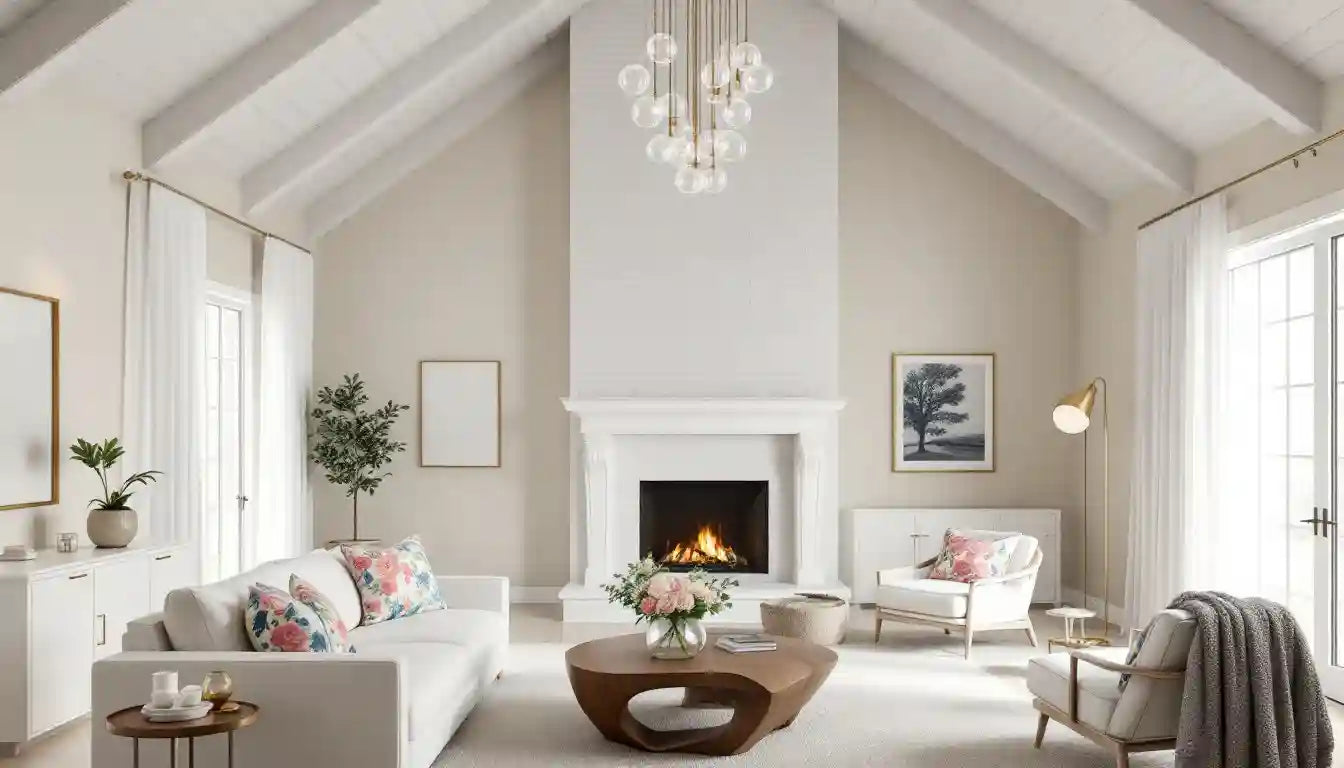
How Long Should Curtains Be? The Ultimate Guide to Perfect Curtain Length
Curtain length isn’t just about covering windows—it’s about transforming your space. The right length can make your room feel taller, cozier, or even more elegant. For example, long curtains that hover above the floor create a polished look, while shorter ones bring a casual vibe. Hanging your curtains higher can also make small rooms feel bigger. So, how long should your curtains be? It all depends on the style and function you want to achieve.
Key Takeaways
Pick the right curtain length for each room's use. Short curtains are great for kitchens, while long ones look fancy in living rooms.
Measure carefully to make curtains look neat. Use a metal tape measure and mark spots with painter's tape to prevent errors.
Hang curtains higher than the window to make walls look taller. This easy tip can make small rooms seem bigger.
Types of Curtain Lengths and Their Ideal Uses
Picking the right curtain length can change your room’s look. Each length has a special purpose, mixing style with usefulness. Let’s check out the most common types and where they work best.
Sill-Length Curtains
Sill-length curtains stop at the window sill. They’re great for places like kitchens or bathrooms where you need practicality. These curtains keep it simple while making your windows look nice.
Tip: Got a radiator or furniture under your window? Sill-length curtains are a smart pick. They won’t get in the way and are easy to clean.
Why do people love them? They give a classic look without crowding small rooms. Plus, they let in sunlight while keeping your privacy.
Apron-Length Curtains
Apron-length curtains hang just below the window sill, about 6 inches. They’re a mix of casual and formal, fitting well in modern or simple designs.
These curtains are great for home offices or guest rooms. They’re stylish but still practical.
Fun Fact: Apron-length curtains became popular in the 1900s when fabrics like polyester made them easier to care for.
Floor-Length Curtains
Floor-length curtains stop just above the floor, about 1–2 centimeters. They’re perfect for living rooms and bedrooms, giving a timeless and classy look.
These curtains make rooms feel taller by drawing the eye upward. They’re flexible—you can pair them with heavy drapes for a fancy look or light sheers for a relaxed feel.
Expert Insight: Lauren suggests floor-length curtains with a small gap from the floor. This keeps the fabric from stretching and still looks neat.
Trouser-Length Curtains
Trouser-length curtains go slightly past the floor, creating a small “break” in the fabric. This style is fancy but not too dramatic.
You’ll see these curtains in formal spaces like dining rooms or master bedrooms. They add a polished and upscale vibe.
Pro Tip: Using heavy fabrics like velvet? Trouser-length curtains can make them look softer and more luxurious.
Puddle-Length Curtains
Puddle-length curtains gather on the floor, about 10–20 centimeters. They’re super elegant and romantic, often used in fancy rooms or spaces with tall ceilings.
These curtains stand out but need more care. Dust can collect on the fabric, so they’re better for rooms where style matters more than function.
Did You Know? Puddle-length curtains are common in luxury homes and old-style interiors. They create a dramatic and unforgettable look.
Curtain Length |
Best Use |
|---|---|
Sill-Length |
Kitchens, bathrooms, or rooms with radiators or furniture below windows. |
Apron-Length |
Guest rooms, home offices, or simple designs. |
Floor-Length |
Living rooms, bedrooms, or spaces needing a classy touch. |
Trouser-Length |
Formal dining rooms or master bedrooms for a neat look. |
Puddle-Length |
Fancy rooms or tall spaces for a dramatic style. |
Every curtain length has a role in decorating. Whether you want something useful or stylish, there’s a perfect option for you.
How to Measure Curtain Lengths
Measuring curtains correctly is important for a neat look. Whether you want floor-length or puddle-length curtains, accurate measurements help them fit well and improve your room. Follow this guide to measure like an expert.
Tools You’ll Need for Measuring
Before starting, gather these tools to make measuring easier:
Metal tape measure: Gives exact and reliable measurements.
Painter’s tape: Marks spots on the wall as a guide.
Step stool or ladder: Helps you reach high curtain rods.
Notebook and pen: Write down measurements to avoid errors.
Pro Tip: Measure twice to be sure. Even small mistakes can make curtains too short or long.
Measuring for Sill-Length Curtains
Sill-length curtains work well in casual areas like kitchens. To measure for these, follow these steps:
Measure from the top of the rod to the window sill.
For below-sill curtains, add 7 inches instead.
Quick Tip: Use a straight tape measure and keep it upright for accuracy.
Measuring for Floor-Length Curtains
Floor-length curtains are great for living rooms and bedrooms. They stop just above the floor for a clean look. Here’s how to measure:
Measure from the curtain rod to the floor.
Add 0.2 inches so the curtains lightly touch the floor.
Expert Advice: Place the rod 2/3 of the way between the window and ceiling. This makes windows look taller and rooms feel bigger.
Measuring for Puddle-Length Curtains
Puddle-length curtains bring elegance to formal spaces. They gather on the floor for a fancy effect. To measure for these:
Measure from the rod to the floor.
Add 10–20 inches, depending on how much fabric you want to pool.
Note: Puddle-length curtains need extra care. Dust collects easily, so they’re best for stylish rooms over practical ones.
Measurement Tips |
Description |
|---|---|
Marking measurements |
|
Curtain width |
Multiply the window’s width by 1.5 to 2 for good coverage. |
Avoid common errors |
Always use a tape measure—don’t guess. |
By following these steps, your curtains will fit perfectly and match your room’s style. Good measurements make a big difference in creating a polished look.
Curtain Hanging Tips for a Polished Look
Perfecting the length of your curtains is only half the battle. How you hang them can make or break the look of your space. Let’s dive into some essential tips to ensure your curtains look polished and professional.
Rod Placement: How High to Hang Curtains
The height of your curtain rod can dramatically change the feel of your room. Follow these simple guidelines to get it just right:
Height Above the Window: Start by hanging the rod 4–6 inches above the window frame. For a more dramatic effect, especially in rooms with standard 8-foot ceilings, go higher—12–16 inches above the frame works beautifully.
Curtain Length: Add 2–4 inches to the rod height when measuring for floor-length curtains. This ensures they skim the floor or create a subtle puddle.
Width of the Rod: Extend the rod 6–12 inches beyond each side of the window frame. This trick makes your windows look larger and lets in more light when the curtains are open.
Pro Tip: Hanging your curtains closer to the ceiling creates the illusion of taller walls, making your room feel more spacious.
Curtain Width and Proper Coverage
Curtain width is just as important as length when it comes to achieving a balanced look. Here’s how to get it right:
Choose curtains wide enough to cover the entire window, even when drawn. For a full, luxurious look, aim for panels that are 1.5 to 2 times the width of your window.
Floor-to-ceiling curtains not only enhance the height of your room but also add a touch of drama.
Layering curtains, such as pairing sheer panels with heavier drapes, boosts both functionality and style. This combination gives you control over light and privacy while adding depth to your decor.
Quick Tip: Custom curtains are a great option for oversized windows or sliding glass doors. They eliminate gaps and ensure complete coverage.
Float Curtains vs. Floor-Length Curtains
Choosing between float curtains and floor-length curtains depends on your room’s vibe and functionality.
Float curtains, which hover just above the floor, are practical for casual spaces and high-traffic areas. They’re easy to maintain and work well with lighter fabrics like cotton.
Floor-length curtains, especially puddle-length styles, bring a luxurious and formal feel to your space. Heavier fabrics like velvet enhance this look, making it perfect for elegant dining rooms or master bedrooms.
Did You Know? Float curtains are ideal for everyday use, while floor-length curtains shine in spaces where you want to impress.
By following these tips, you’ll not only achieve the perfect curtain length but also elevate the overall look of your room.
Choosing the Best Curtain Length for Your Room
Living Rooms and Dining Rooms
Floor-length curtains are a timeless pick for living and dining rooms. They give a neat and stylish look that matches most furniture setups. For a fancier vibe, try trouser-length curtains that touch the floor lightly. These are great for formal dining spaces or areas where you host guests.
Tip: Place the curtain rod higher than the window to make the room seem taller. Extending the rod wider than the window lets in more light when curtains are open.
For big windows or sliding doors, choose wider curtain panels for full coverage. Adding sheer curtains with heavier ones can make your design more flexible and layered.
Bedrooms
Curtain length in bedrooms affects both style and function. Floor-length curtains create a warm and peaceful feel. They also block light well, especially with blackout liners. For a fancy touch, puddle-length curtains add romance, especially in master bedrooms.
Quick Tip: Use thick fabrics like velvet or cotton for better privacy and insulation. These materials look nice and keep your room comfy all year.
If you like a simpler style, float curtains that stop just above the floor are easy to care for and practical.
Kitchens
Kitchens need shorter curtains for convenience. Sill-length or apron-length curtains work best since they stay out of the way while cooking or cleaning. Cafe curtains are a favorite for kitchen windows, especially above sinks. They give privacy but still let in sunlight, making them both useful and stylish.
Cafe curtains fit small windows perfectly.
They look great in modern or farmhouse-style kitchens.
Their flexibility makes them a popular kitchen choice.
Did You Know? Short curtains are easier to clean, which is helpful in kitchens where spills happen often.
Formal Spaces vs. Casual Spaces
Curtain length sets the mood of a room. In formal areas like dining rooms, longer curtains like trouser-length or puddle-length add elegance. These styles pair well with heavy fabrics like silk or velvet for a dramatic look.
In casual spaces like family rooms, sill-length or float curtains are better. They’re easier to clean and perfect for busy areas.
Pro Tip: Match curtain length to the room’s purpose. Use long, fancy curtains for formal rooms and simple, short ones for casual spaces.
Choosing the right curtain length makes your room both beautiful and functional.
The right curtain length can completely transform your space. It’s not just about looks—it’s about function too. Think about your room’s purpose, window size, and style. As experts say:
“The trend for drapery panels is for them to ‘kiss’ or skim the floor. This look is classic and works in most decor settings.”
Choose what feels right for your home.
FAQ
How do I choose the right curtain length for my room?
Think about the room’s purpose. For formal spaces, go with floor or puddle-length curtains. For casual areas, sill or apron-length curtains work best.
Tip: Match curtain length to your room’s vibe for a cohesive look.
Can I use long curtains in small rooms?
Absolutely! Hanging floor-length curtains higher than the window frame makes small rooms feel taller and more spacious.
Pro Tip: Extend the rod beyond the window for extra light and a larger feel.
What’s the easiest way to measure curtain length?
Use a metal tape measure. Measure from the rod to your desired length (sill, floor, or puddle). Always double-check your measurements for accuracy.
Quick Tip: Mark your measurements with painter’s tape before buying curtains.








